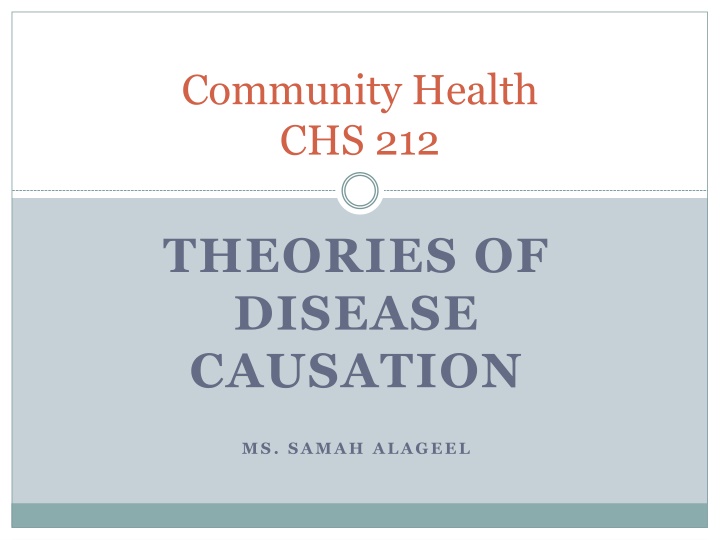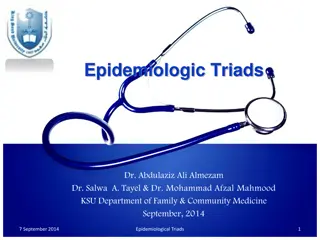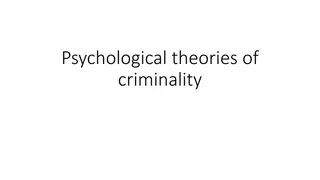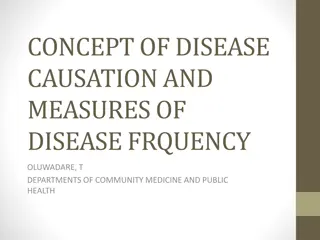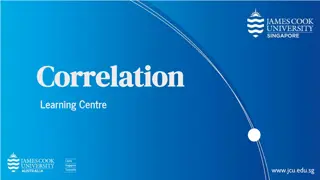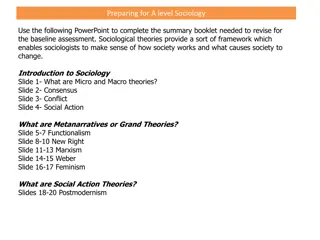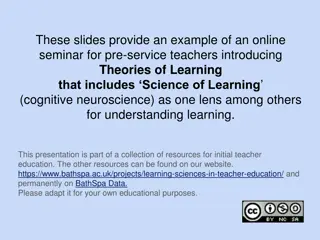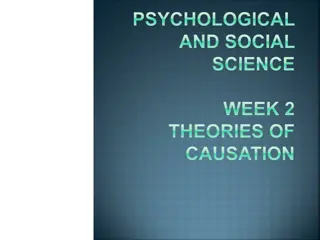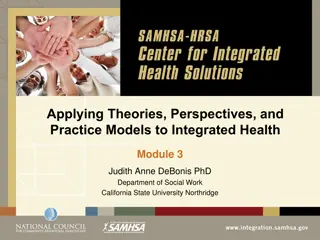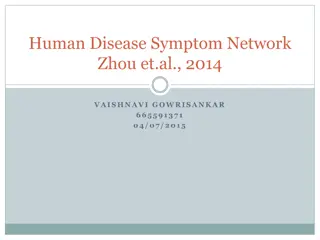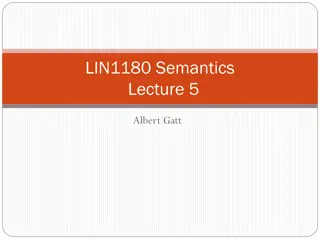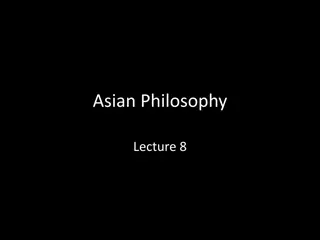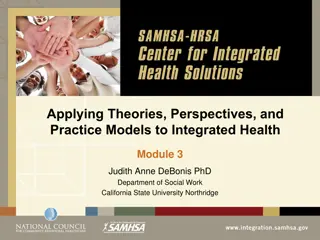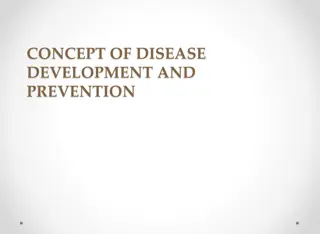Theories of Disease Causation and Historical Perspectives
Explore the evolution of disease causation theories from miasma theory to germ theory, epidemiological models, and the socio-environmental approach. Understand the definition of disease, its causes, and how ancient beliefs in spiritual or mechanical forces led to new scientific interpretations.
Download Presentation

Please find below an Image/Link to download the presentation.
The content on the website is provided AS IS for your information and personal use only. It may not be sold, licensed, or shared on other websites without obtaining consent from the author.If you encounter any issues during the download, it is possible that the publisher has removed the file from their server.
You are allowed to download the files provided on this website for personal or commercial use, subject to the condition that they are used lawfully. All files are the property of their respective owners.
The content on the website is provided AS IS for your information and personal use only. It may not be sold, licensed, or shared on other websites without obtaining consent from the author.
E N D
Presentation Transcript
Community Health CHS 212 THEORIES OF DISEASE CAUSATION MS. SAMAH ALAGEEL
Outline: Definition of disease. The gradual development of disease causation: Miasma theory. Germ theory. Epidemiological models of disease. Web of causation. The theory of general susceptibility. The socio-environmental approach. Conclusion.
What is disease?? OPPOSITE TO HEALTH
Definition of disease: A condition in which body function is impaired, departure from a state of health, an alteration of the human body interrupting the performance of the vital functions. - Webster.
Definition of disease: (Cont.) The condition of body or some part of organ of body in which its functions are disrupted or deranged - Oxford English Dictionary
How disease is caused? Before the rise of modern medicine, disease was attributed to a variety of spiritual or mechanical forces, including: A punishment from God for a sinful behavior. Weak moral character. Witchcraft.
How disease is caused? (Cont.) However, these disease causation interpretations were challenged and changed as the theories of disease causation was developed, changing people s views of diseases as related to specific agents and other environmental factors.
How disease is caused? (Cont.) Theories of disease causation: o Miasma theory. o Germ theory. o Epidemiological triangle. o Web of causation o The theory of general susceptibility. o The socio-environmental approach.
Miasma Theory The word "miasma" comes from ancient Greek and means "pollution". Miasma was considered to be a poisonous vapor or mist filled with particles from decomposed matter (miasmata) that caused illnesses.
Miasma Theory (Cont.) In the 1850s, miasma was used to explain the spread of cholera in London and in Paris. In China, miasma was thought to be caused by the heat, moisture and the dead air in the Southern Chinese mountains. They thought that insects waste polluted the air, water. The miasma theory observations that disease was associated with poor sanitation. was consistent with
As a result of the miasma theory The sanitary movement era (The first half of the nineteenth century) Public sanitation. 2. Focus was on disease prevention (causes of diseases in population) and the health needs of poor population. 3. The epidemiology were population-wide health improvement. health measure were concerned with 1. largely involved in
Germ theory Health problems were believed to be the product of living organisms which entered the body through food, water, air or the bites of insects or animals. It was believed that each disease has a single and a specific cause (mono-causal approach).
The result of the Germ Theory: Researches were moved from the community to the laboratory and concentrated on the identification of agents for a given disease. Medical practice became devoted to the destruction or eradication of the agent from individuals already affected.
Epidemiological triangle According to this theory, exposure to an agent does not necessarily lead to disease. It was believed that disease is the result of an interaction between agent, host and the environment.
Health Behavior Immunity Sex Age Genetic makeup Noise Bacteria Air Viruses Water Fungi Sanitation
As a result of the epidemiological triangle theory: It was believed that diseases can be prevented by modifying factors which influence exposure and susceptibility. This is useful in understanding infectious disorders, but less useful in dealing with chronic, degenerative diseases such as heart diseases and diabetes. For these disorders there is no specific agent that could be identified against which individual and population may be protected.
Web of causation According to this concept, disorders are developed through complex interaction of many factors. These factors maybe biophysical, social or psychological and may promote or inhibit the disease at more than one point in the causal process. Ultimately, they determine the level of disease in a community.
Cause Cause Effect \ Disease Cause Cause
As a result of this theory: Based on this theory, it is believed that prevention offers a better prospects for health than cure, since many of these factors can be modified. Since several factors contributes to several diseases, community efforts were shifted to factors modification (prevention) rather than disease treatment.
Theory of general susceptibility This theory is not concerned with identifying single or multiple risk factors associated with specific disorders. It seeks to understand why some social groups seems to be more susceptible to disease and death in general. This reflects an imperfectly understood general susceptibility to health problems.
Examples: Low social class Higher rates Lung Cancer Ischemic heart diseases Respiratory disease Cerebro-vascular disease
Examples (Cont.): African American Higher risk group Diabetes (NIDD) Hypertension Stroke Dementia Prostrate cancer
The socio-environmental approach This approach is not so much concerned with the causes of disease, rather it seeks to identify the broad factors that make and keep people healthy . It is concerned with the population rather than individuals.
Factors that improve peoples health: Based on the socio-environmental approach, five broad factors that can be targeted in order to improve population health : The social and economic environment. The physical environment. Personal health practices. Individual capacity and coping skills. Health services.
As a result of this theory: Health actions shifted from the individual to the community as a whole. Improving health requires political and regulatory actions to modify social, economical and physical environment.
Conclusion As briefly described, it is clear that the role attributed to the physical, social and psychological environment increases as we have progressed from the germ theory to socio-environmental models of health. The idea of diseases causation have moved from one specific etiology to a broad non-specific multi factors that are seen to be associated with a variety of disease outcomes and ultimately the health and wellbeing of the population.
The actual causation of particular forms of disease is in many cases obscure, because of the limitations of our present knowledge.
Now its time to do it yourself Depression Hypertension Obesity Malnutrition Lung cancer
